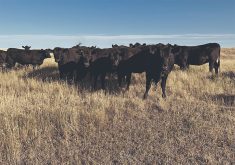Water quality and forage decisions are key factors for producers to consider in areas where moisture remains scarce
Dry conditions remain a concern for many cattle producers, despite rain in some parts of the Prairies.
At the Canadian Beef Industry Conference, researcher Bart Lardner and rancher Tara Mulhern-Davidson discussed ways to prepare for future drought years.
“It’s a bit of a bleak topic,” said Mulhern-Davidson.
Read Also

Canada’s slaughter horse industry lacks transparency
The lack of clear reporting and public access to data keeps the industry largely hidden, leaving questions about humane treatment and traceability unanswered.
“I would love to stand up here and share insight on wonderful successes on our farm, but instead, we’re going to talk about how to stick-handle through some tough challenges.”
Though some regions got more rain this year than they have in the past four, Lardner said it doesn’t mean they are out of the woods. After such a prolonged period of drought, the ground hasn’t been recharged.
“It really sets the producer up where it’s hard,” he said about drought. “You’re banking on this or that resource and all of a sudden May comes along and things are looking pretty bad.”
Herd management is an individual process unique to each operation, but there are options to consider.
Mulhern-Davidson, who operates Lonesome Dove Ranch near Ponteix, Sask., had to decide whether to haul water and whether to retain fewer heifers than usual. When water is scarce, it’s important to test its quality so decisions can be made.
“Do not trust your gut with water quality. Do the test. Our worst-quality water is crystal clear, looks great. Our best-quality water is turbid, it’s cloudy, it looks terrible. So, I do take water samples into the ministry of agriculture. We also build rations based on the water quality that we have.”
Forage decisions are also key.
Lardner said producers should consider drought-resistant kochia or annual winter cereals as potential feed sources. Annual forages require less moisture than perennials. Cropland can also be grazed if necessary.
“Look at some of those salvage crops too,” he said. “So you might have seeded that for a cash crop, but all of a sudden it’s looking pretty handy for pasture.”
At Lonesome Dove Ranch, Mulhern-Davidson said they cut and baled some of their forages during drought so grasshoppers and gophers wouldn’t deplete supplies. They also grew drought-resistant cereals including fall rye.
“I don’t know where our farm would be if we didn’t have winter cereals, to be honest,” she said. “It gets out there before the gophers and the grasshoppers do, covers the ground.”
Drought resistance, rather than cattle preference, must be the main focus.
“When it comes to feed, you really have to be prepared to expand your definition of what you think feed is, and don’t impose your limitations or other people saying, ‘oh, my cows don’t like fall rye,’ or ‘cows won’t eat kochia’,” she said. “Cows don’t know what they won’t eat because they will eat what you give them, if that’s the option.”
Knowing all the options will help producers manage through drought. Post drought, Lardner said they should consider resting pastures to allow them to rejuvenate.
Beyond basic management, a good community helps when things are tough, added Mulhern-Davidson.
“It’s not government program ad hoc payments that are going to fix this. It’s not feed that’s going to fix this. It’s not even rain that’s going to get us through this. It’s the people.
“It can be really hard, but there’s no more resilient, innovative, resourceful group of people than beef and forage producers because we’re there for each other.”


















